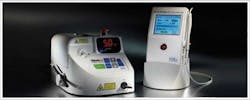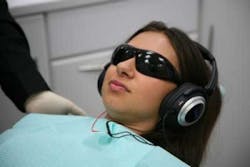Lasers to treat tooth sensitivity
By Maria Perno Goldie, RDH, MS
Lasers are used in dentistry for a variety of purposes, one is to treat tooth hypersensitivity. There are not many recent studies on this topic, but anecdotal accounts are prevalent. Use of Nd:YAG laser irradiation has been supported for the mitigation of symptoms from dentin hypersensitivity. They are thought to work by coagulation of proteins in the dentinal fluid and hence reduce permeability.(1)A small study testing low level laser therapy (Gallium/Aluminium/Arsenide laser [GaAIAs]) against placebo was carried out in the management of dentinal tooth hypersensitivity.(2) The results of this study demonstrated that the GaAIAs laser is an effective method for the treatment of both thermal and tactile dentinal hypersensitivity. There were no reported adverse reactions or instances of oral irritation.A clinical trial was conducted to test the efficacy of the Nd:YAG dental laser in treating tooth sensitivity. An electronic monitoring machine was used which allowed for air stream, directed at a patient's tooth, to be started by the clinician and halted by the patient when the sensation of pain in the tooth became too unpleasant to tolerate. The time for which the patient could tolerate the air flow was electronically measured in units of 1/50th second. By measuring the patient's reaction time on each visit and correcting the readings obtained for "tooth pain time" using these figures, a quantitative measure of sensitivity change is achieved. The thirty patients treated had an average tooth pain time initially of 1.2 seconds. Following laser treatment patients were recalled at 3, 7 and 14 days. At the 2-week review, this figure had increased to 7.8 seconds, which was found to be statistically significant. Control (unlased) teeth demonstrated an average improvement of only 1.7 seconds (not statistically significant). Patients' subjective assessment of sensitivity pain on a 0-10 scale averaged 8.0 before treatment. This reduced to 3.7 after treatment. Treatment of this condition can thus be performed easily and painlessly with a predictable response and considerable patient satisfaction.(3)
According to the authors of another study, an ideal material had yet to be discovered (2005) that can completely treat dentin hypersensitivity. They postulated that if a highly biocompatible material such as bioglass could be melted by laser irradiation to achieve better sealing depth for dentinal tubules, it may subsequently bond to dentin structures under a physiological environment and offer a prolonged therapeutic effect. The authors used four types of energy parameters to melt the composition-modified bioglass. These four types were 30Hz, 330mJ/pulse (G+ mode), 30Hz, 160mJ/pulse (G− mode), 10Hz, 400mJ/pulse (D+ mode), and 10Hz, 200mJ/pulse (D− mode). The temperature elevation, occlusive depth of bioglass, and phase changes in the bioglass after laser irradiation were evaluated by means of scanning electron microscope (SEM), thermometer, and X-ray diffractometer (XRD). The results showed the occlusive depths of 2 and 10μm in the dentinal tubules were achieved when the bioglass underwent 30Hz, 160mJ/pulse (G− mode) and 30Hz, 330mJ/pulse (G+ mode) of laser treatments, respectively. The bioglass experienced a temperature increase of less than 600°C, and no phase transformation was observed after Nd:YAP (yttrium aluminum perovskite doped with neodym) laser irradiation. According to the authors, the melting point of a composition-modified bioglass could be reduced and its use plus Nd:YAP laser have the potential in clinical use to treat dentin hypersensitivity.(4) A newer study compared Nd:YAG Laser and Fluoride Varnish for the Treatment of Dentinal Hypersensitivity.(5) According to the authors, various methods and materials are used in the treatment of dentin hypersensitivity. The aim of this small, randomized prospective controlled clinical trial was to evaluate and compare the desensitizing effects of the neodymium-doped yttrium aluminium garnet (Nd:YAG) laser and fluoride varnish by considering the degree of pre- and posttreatment pain, discomfort, and functional complications. The results of the study showed that the Nd:YAG laser is a suitable tool for the immediate and successful reduction of dentinal hypersensitivity than application of fluoride varnish and had a better patient satisfaction and shorter treatment time, in this study.
One last study I will mention was published in 2005. The objective of this in-vitro study was to evaluate the effects of six in-office agents of desensitization on the hydraulic conductance of human dentin by measuring the mean percentage reduction in permeability over a period of one month. The tested agents were Fluoride varnish (Fluorprotector), resin desensitizer (Gluma desensitizer), adhesive resin (Gluma comfort bond), laser (Nd:YAG Laser), fluoride iontophoresis (Electric pulp tester, for fluoride iontophoresis) and 3% Potassium oxalate (freshly prepared). Sixty non-carious, intact human mandibular third molars were sectioned at mid-coronal region and polished to obtain 1 mm thick discs which were divided into six groups. The results of this study indicate that all the tested agents led to a decrease in dentin permeability Nd:YAG laser gave the highest reduction in permeability throughout the entire period of study followed by Gluma desensitizer Gluma comfort bond, Fluoride iontophoresis, and Fluor protector and 3% Potassium oxalate was the least effective.(6)Other clinical studies do not support this finding, with the laser treatment reducing the pain sensation but not significantly different from the placebo treatment. In summary, the clinical results obtained from laser therapy are equivocal, and further studies are needed.(7) For more information on lasers, please visit: Academy of Laser dentistry at www.laserdentistry.org. Lasers shown in this article are two Odyssey Diode Lasers from Ivoclar Vivadent and the HygieneLase - Diode Laser by Zap (Discus).References
1. Goodis HE, White JM, Marshall SJ et al. Laser treatment of sensitive dentine. Arch Oral Biol 1994 39: 128.2. Gerschman JA, Ruben J, Gebart-Eaglemont J. Low level laser therapy for dentinal tooth hypersensitivity. Australian Dental Journal, Volume 39, Issue 6, pages 353–357, December 1994.3. Renton-Harper P, Midda M. NdYAG laser treatment of dentinal hypersensitivity. Br Dent J. 1992 Jan 11;172(1):13-6.4. Bor-Shiunn Lee, Chun-Wei Chang, Weng-Pin Chen, Wan-Hong Lan, Chun Pin Lin. Invitro study of dentin hypersensitivity treated by Nd:YAP laser and bioglass. Dent Mater 2005; 21 (6): 511-19.5. Kara C, and Orbak R. Comparative Evaluation of Nd:YAG Laser and Fluoride Varnish for the Treatment of Dentinal Hypersensitivity. J Endod 2009;35:971–974.6. Joshua M, Emmanuel, Kandaswamy D. Effects of six in-office agents of desensitization on the permeability of dentin - An in-vitro hydraulic conductance study. J Conserv Dent 2005;8:14-25.7. Lier BB, Rosing CK, Aass AM et al. Treatment of dentine hypersensitivity by Nd:YAG laser. J Clin Periodontol 2002 29: 501-506.Additional ReadingWest N X. The dentine hypersensitivity patient – a total management package. International Dental Journal (2007) 57, 411-419.www2.cochrane.org/reviews/en/title_50534901927363431104101116145945.html
1. Goodis HE, White JM, Marshall SJ et al. Laser treatment of sensitive dentine. Arch Oral Biol 1994 39: 128.2. Gerschman JA, Ruben J, Gebart-Eaglemont J. Low level laser therapy for dentinal tooth hypersensitivity. Australian Dental Journal, Volume 39, Issue 6, pages 353–357, December 1994.3. Renton-Harper P, Midda M. NdYAG laser treatment of dentinal hypersensitivity. Br Dent J. 1992 Jan 11;172(1):13-6.4. Bor-Shiunn Lee, Chun-Wei Chang, Weng-Pin Chen, Wan-Hong Lan, Chun Pin Lin. Invitro study of dentin hypersensitivity treated by Nd:YAP laser and bioglass. Dent Mater 2005; 21 (6): 511-19.5. Kara C, and Orbak R. Comparative Evaluation of Nd:YAG Laser and Fluoride Varnish for the Treatment of Dentinal Hypersensitivity. J Endod 2009;35:971–974.6. Joshua M, Emmanuel, Kandaswamy D. Effects of six in-office agents of desensitization on the permeability of dentin - An in-vitro hydraulic conductance study. J Conserv Dent 2005;8:14-25.7. Lier BB, Rosing CK, Aass AM et al. Treatment of dentine hypersensitivity by Nd:YAG laser. J Clin Periodontol 2002 29: 501-506.Additional ReadingWest N X. The dentine hypersensitivity patient – a total management package. International Dental Journal (2007) 57, 411-419.www2.cochrane.org/reviews/en/title_50534901927363431104101116145945.html
Maria Perno Goldie, RDH, MS
To read other FOCUS articles written by Maria Perno Goldie, RDH, MS, go to articles.




